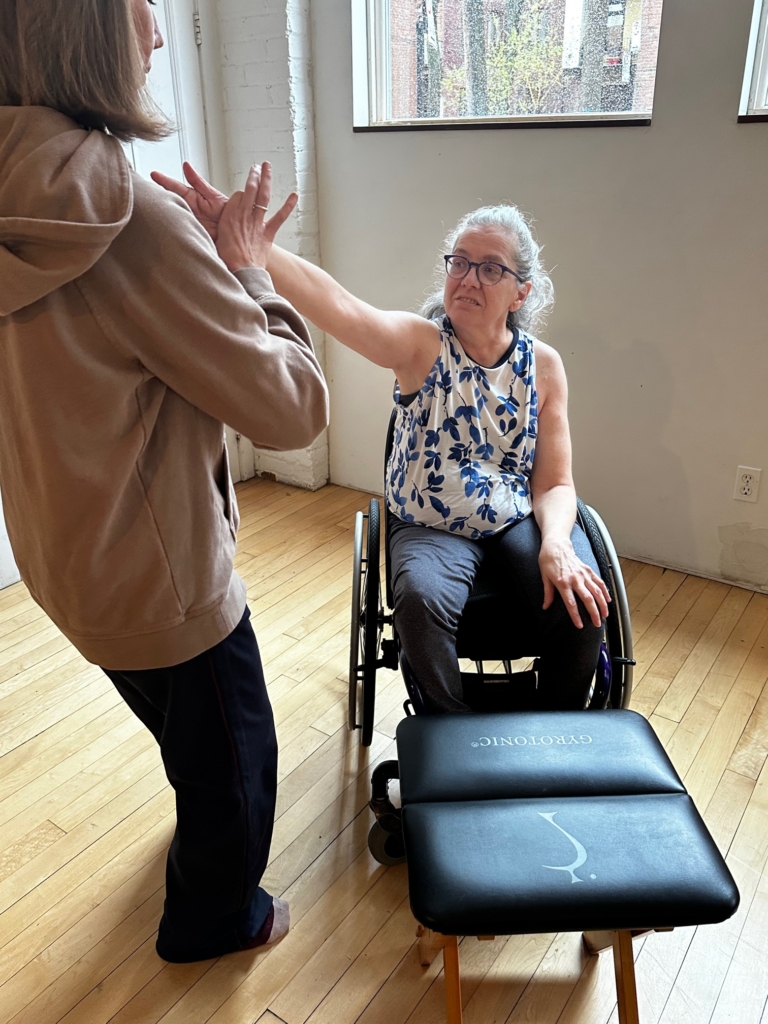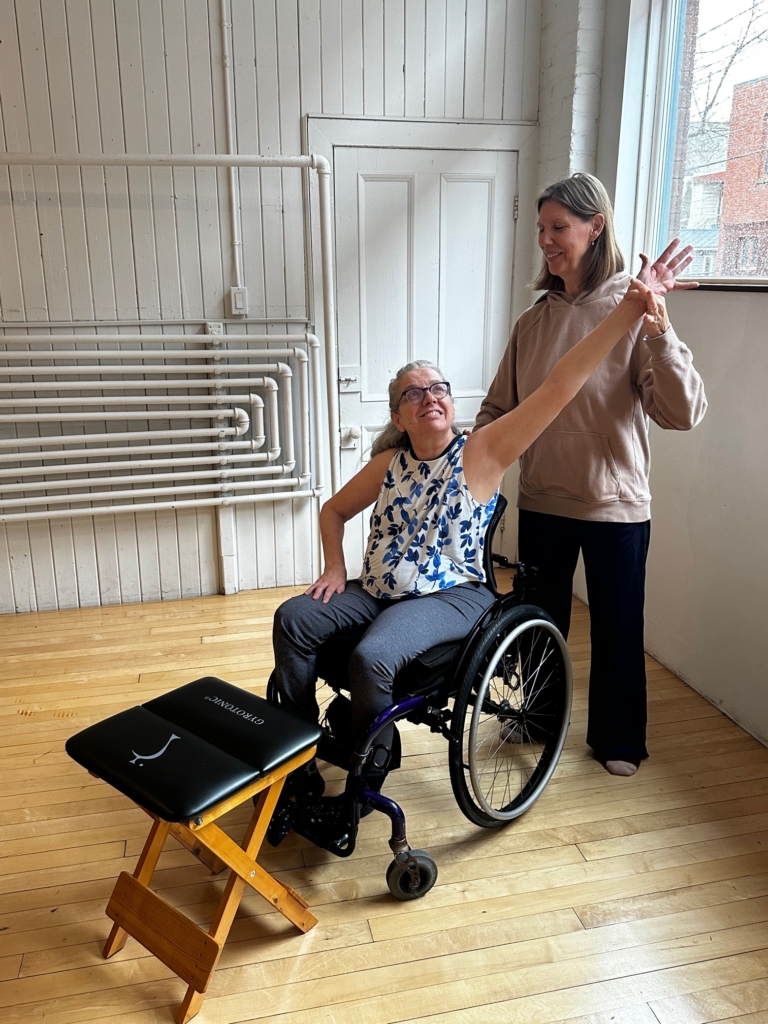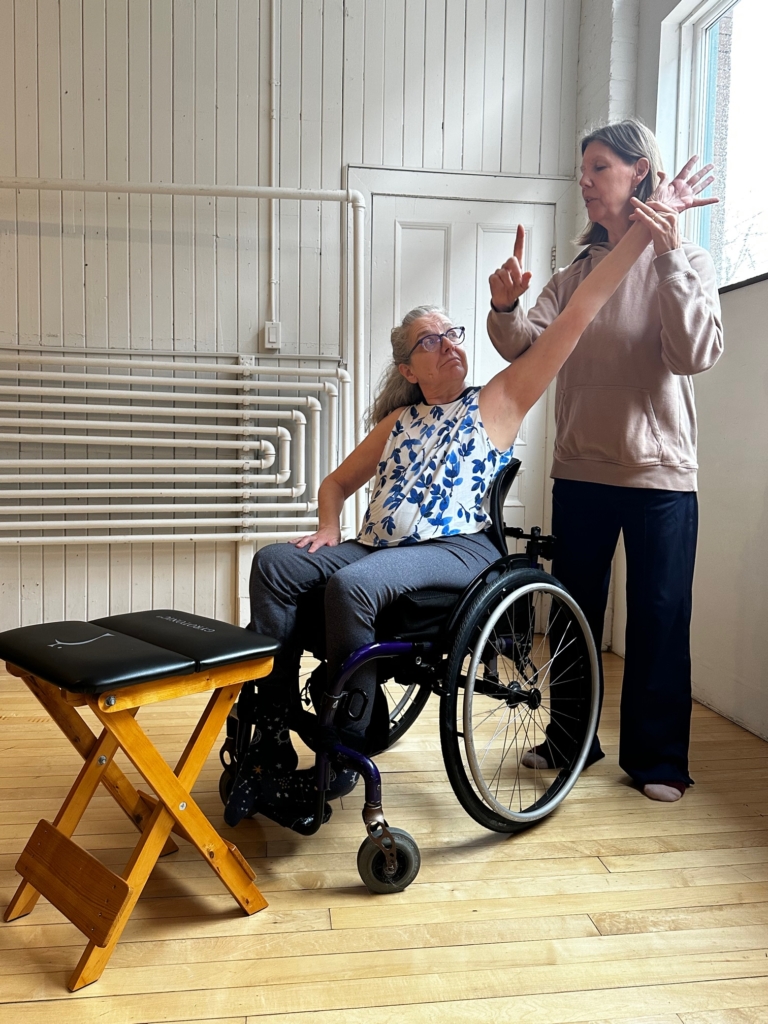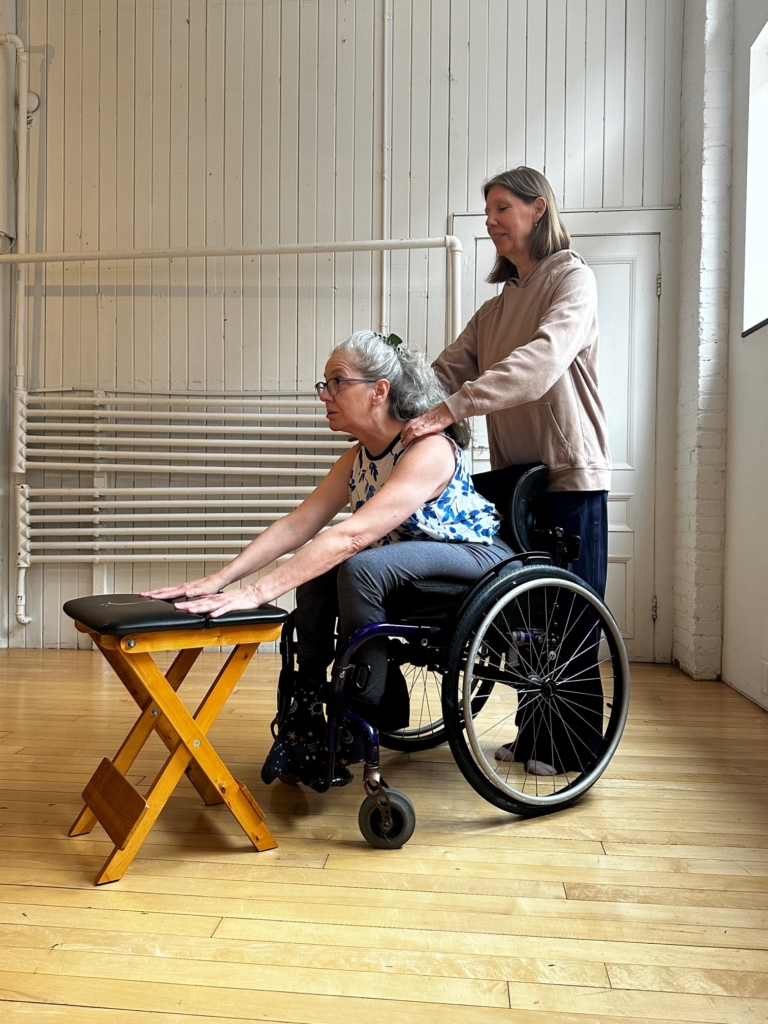Awareness and Imagination: The GYROKINESIS® Method from a Wheelchair
Blog Content Interviews Testimonial // July 19, 2023
Liz Winkelaar is a Gyrokinesis Trainer, choreographer and dancer. She earned a Master’s degree in Canadian Studies at Carleton University, leading to an interest in Disability Art and Culture and to Propeller Dance. In addition to dancing in Propeller Dance’s company, she has taught outreach workshops for Propeller, assisted with the children’s program, and pioneered the Company’s seniors’ program. Liz is the recipient of the Celebration of People’s Artistic Excellence award (2012) and Propeller’s Emerging Choreographers program, through which she directed the original dance piece Spasticus (2016, GCTC) alongside choreographer Renata Soutter. She lives this vibrant life from a manual wheelchair. When we learned about her three-year journey to become a Gyrokinesis Trainer, we knew her story would be an inspiration to our whole community. Enjoy!
You can also listen to this interview through the recording below.
Cina: Tell me a bit about your life and what you do. I’d love to know more about who you are.
Liz: My name is Liz Winkelaar. I’m a 60-year-old white woman with long, gray, curly hair, and I use a manual wheelchair. I came from Lindsay, Ontario, a small town north of Toronto. I’ve always loved dance. I was never much into sports, but I loved dance.

Liz Winkelaar with Dana Gingras
I went off to university. In my first year, I got into a motorcycle accident with my boyfriend and became a paraplegic. He was not injured. I was 18 at the time, and we got married. We had two kids together, then we both became teachers.
Cina: What were you teaching?
Liz: I was teaching elementary school. I just wore myself out. I did too much. I got paralyzed. I had one baby. I had another baby. I went to university. I became a teacher. I tried to teach full-time. Basically, I fell apart in so many ways. At the same time, my marriage fell apart. So, I was pushing 40, newly single, and I was not able to do my teaching job anymore. My kids were teenagers, and I decided to come to Ottawa because I had been to Carleton University before. I knew it was super accessible.
I took the master’s degree in Canadian Studies. My special topics were women’s issues and policy. I was writing about disability in Canada and doing comparative analysis with issues in Canada, The States, and European countries. I started to realize certain things, like disability is really a social construct. Your experience is largely determined by the government’s policy towards you. Stuff like that started to really sink in for me.
Cina: Do you mind sharing a little bit about what exactly your injury is?
Liz: Oh, sure. There was an impact injury, so my spine went down on top of the motorcycle seat. The spine itself got crushed and severed the spinal cord. It’s quite drastic. They have to rebuild a little bit of your spine and fuse it together. I have several vertebrae fused together, so there’s some real tightness, right? You’re actually fused. When your spinal cord gets severed like that, you don’t feel or move anything below the level of your injury. I found that after years, I never did move, but I did start to feel things. I feel a lot more when I do the GYROTONIC® Method.
Cina: I think your story is just incredible. I’ve only known of one other trainer who is in a manual wheelchair. For our audience who aren’t familiar, could you explain what it means for a place to be accessible?
Liz: Accessible means, can I get in the door? If I’m going to be there for hours, can I use the washroom? I would love to go study the Gyrokinesis and Gyrotonic Methods with others, but I’m worried about accessibility.
The Benefit of the Gyrotonic and Gyrokinesis Methods
Cina: I would love to learn more about what you find to be useful to you, how you found the methods, and how it’s been able to benefit you.
Liz: I met Shara Weaver, Renata Soutter, and Alan Shain, three people that started Propeller Dance in 2007. I fell in love with integrated dance. You’re dancing with people with disabilities and without disabilities together. Some of them are trained contemporary dancers. I was learning so much so fast that I got the master’s degree, then completely devoted myself to Propeller Dance. Now I’m Artistic Lead, so I’m busy with the organization but also still dancing with the company. While also trying to create an artistic practice for myself outside of the company as an independent artist.

Liz Winkelaar with Dana Gingras
I’ve started to apply for grants to do my own pieces. That’s how I met Sioned Watkins. She also took an interest in integrated dance. Any time she was there, she shared the Gyrokinesis Method with us. Then I fell in love with the Gyrokinesis Method. We have people in the company that can hardly move their bodies, they’re quadriplegic, yet you could see the benefits in each and every person’s body. As dancers, it was the best possible practice we could bring in.
So, about four years ago, I did my pre-study with Sioned over several weekends. I feel like that’s one of the greatest acts of mentorship I’ve ever received because it fits in with everything I want to do with my body, my life, and my community.
I did the Gyrokinesis Foundation Training with Dana Gingras. I was so intimidated by her because she’s a superstar in the world of dance and choreography, but she was so kind, accessible, and present. It’s a new thing, working with somebody who’s injured in a very different way. I really appreciated that. Then the pandemic came, and I was worried I wouldn’t get my teaching time in, but we were able to work it out, and I took my final certificate in February of 2022.
Moving Past Mobility Limitations with the Methods
Cina: That’s super exciting. What would you tell other people who have mobility limitations for various reasons that might be a little scared to try this kind of work, what would your encouragement be?
Liz: I would say they need to try the Gyrokinesis Method because you can do it sitting down. It’s amazing that you can do such a full workout sitting down. I would tell them that, at the very least, you’re going to feel good, you’re going to have more oxygen, and you’re going to restore your equilibrium. Those things are very important. In the long run, you can’t find a better practice for your resilience, your range of motion, and your strength. It’s so easy because you just follow, and every time you learn more and more. You start to understand the breathing and how everything connects. The very first session of the Gyrokinesis Method was awesome. I remember feeling so invigorated and at peace. Like I’d done a good workout. I felt more energetic than at the beginning. That’s what always surprised us, and that’s why I wanted more.
I think because I’m paralyzed, I’m always working as hard as I can. I’m always lifting myself. I didn’t understand that with the Gyrokinesis Method, more movement might be available. That’s important to everybody, but it’s important to me as a dancer to find ways of creating new movements. That is very exciting.
Discovering Modifications with Imagination
Cina: Can you talk a little bit about exploring and finding modifications?
Liz: Working with Dana, we tried to approximate things when I couldn’t make a big movement. We found that if I used the tall stool, I could lean forward and do the whole Cat Back series in that position. It was effective for me in all the right ways. In some cases, you can find the right support.

Liz Winkelaar with Dana Gingras
If you can’t do it with your body, you do it with your imagination. I seem to be able to focus on the legs and start to feel the legs now. I always put pressure down. Like when you are putting pressure down on the floor, I’m doing that to my legs with my hands. I can feel the grounding happening in my legs in a whole different way.
I think continuous motion is very significant. I’ve got terrible scoliosis. Doing static postures is not necessarily a favor to yourself if you’re very crooked. The continuous motion of the Gyrotonic Method is a real asset. The fact that you’re constantly in motion, breathing, and connected allows a gentler opening to an already very crooked body.
Cina: That makes sense. What was the difference in the movement or functionality of your organs below the injury? What was the impact?
Liz: That is a significant problem for people who are paralyzed. How do you keep your systems moving? This is one way that definitely keeps your systems moving. Like I said, I’ve never been able to move anything in my lower body, but I think awareness is very important. If a person can’t move, get them to do it with their eyes, the Figure Eights, everything. I assume that if I can’t move something, it’s okay. It’s about the intention, and there’s a huge element of imagination there.
Cina: I hadn’t really thought of it in that way. How does that work when you’re teaching someone who doesn’t have limitations on their ability?
Liz: Well, that’s tricky. With my own dance company, they know me well enough, and I know them well enough to be able to instruct them. If it’s a new group from the general public, I’m not going to be able to demonstrate everything. So Sioned would be my partner, and she’d demonstrate everything as we go. That’s very helpful, having an able-bodied partner that knows enough to be a model. I love having both of us. If you have a disability, you can model me, or if you’re completely able-bodied, then you’ve got a model as well. I love that about co-teaching.
Cina: That’s fantastic.
Liz: There are phenomenal things that happen for me when I practice daily. I start to be able to feel my legs. I can always feel them a little bit, but it becomes much more intense.
Cina: I didn’t even know that was possible when you have paralysis in your legs. Wow! Is there anything else that you would like to share about your experience with this work?

Liz Winkelaar with Dana Gingras
Liz: The Gyrokinesis Method has been a gift. I’ve put a lot of work into it because it means that much to me. Without it being a gift, I never would have accessed it. If Sioned had not come to us and shared this, along with the generosity of Dana taking on a student who is very different. I might not be able to do all the things, but she trusted me to find ways and to be truthful and authentic about what I was experiencing in my body. I feel the people that I’ve met seem to be people who are very inspired to share this knowledge, and I find that great.
Cina: Let’s end on what’s next. What do you hope to do?
Liz: I really want to travel. I want to reach out to other teachers of the Gyrokinesis Method because this is something important to dancers with disabilities. I can find support to keep doing this. We’re trying new things. We’re taking the whole body of knowledge, but we’re also working with pieces of it to make it more accessible. I feel like I’m dealing with sacred things. I must be authentic about what the effects are and about what the sequences do in my body. We can find the common ground between this able-bodied person and this person who has a disability.
Cina: I think you have an opportunity to fill a huge gap. You are adapting the work to work for you. I’m looking forward to sharing your story.
Currently, Liz teaches free classes at the National Arts Centre in Ottawa, Ontario. You can find more information about her upcoming classes here: Liz Winkelaar at the National Arts Centre
You can read the perspective of Liz’s Master Trainer, Dana Gingras in our post Finding Possibilities: Teacher Training for the GYROKINESIS® Method in a Wheelchair
Take a look at some of these other inspiring stories from our community:
Teaching the GYROTONIC® Method From a Wheelchair
Finding the GYROTONIC® Method 10 Years After a Stroke
Paraplegic Spinal Cord Injuries and the GYROTONIC® Method
To find Gyrotonic and Gyrokinesis classes near you, visit our Studio Finder tool.
To learn more about how to become a Gyrotonic or Gyrokinesis Trainer, visit our Teacher Training page.
